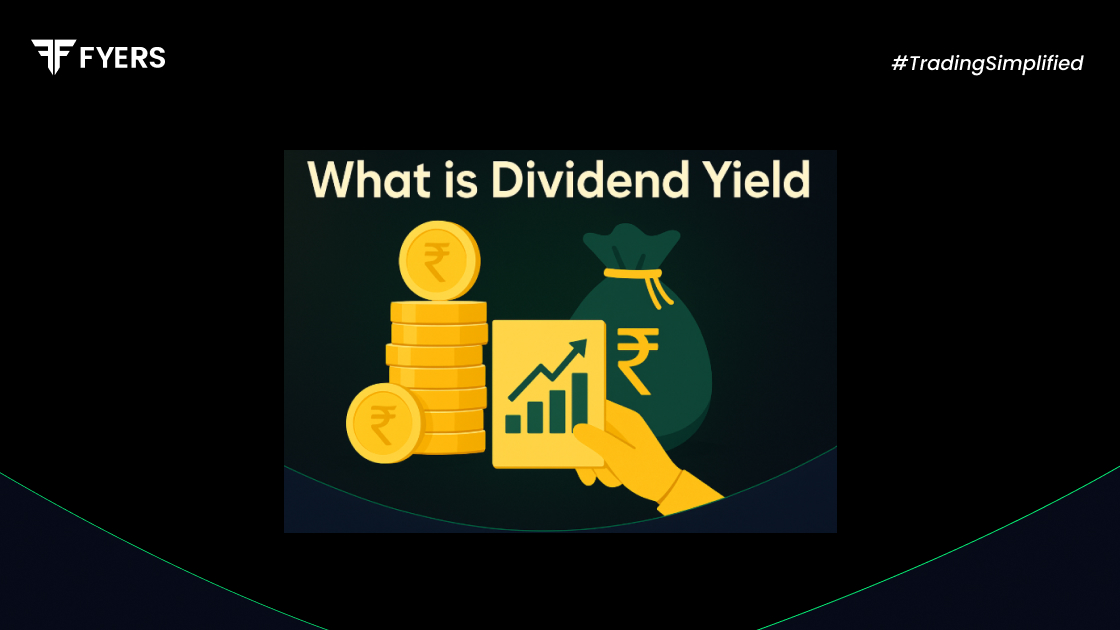

 30 Sep, 2025
30 Sep, 2025
 3 mins read
3 mins read

A dividend yield gives investors a quick snapshot of how much income they can earn from owning a stock compared to its market price. Think of it as the return you receive in the form of dividends rather than capital gains. It is calculated as a percentage and helps investors gauge the attractiveness of a dividend-paying stock.
In simple words, dividend yield answers the question: for every rupee you invest in a company’s shares, how much cash flow can you expect to receive annually? This makes it a key tool for those following dividend investing strategies, especially in steady sectors like utilities, consumer goods, or banking.
The dividend yield formula is straightforward:
|
Dividend Yield (%) = (Annual Dividend per Share / Market Price per Share) × 100 |
Annual Dividend per Share: The total dividend a company pays out in a year per share.
Market Price per Share: The stock’s current trading price.
Notes:
The dividend can be based on trailing 12-month payouts or forward-looking expectations.
Because market prices fluctuate daily, the yield also changes over time.
Suppose:
Annual dividend = Rs. 15 per share
Current market price = Rs. 300
Dividend Yield = (15 ÷ 300) × 100 = 5%
This means for every Rs. 100 invested, you earn Rs. 5 annually in dividend income.
If the price drops to Rs. 250:
(15 ÷ 250) × 100 = 6%
If the price rises to Rs. 400:
(15 ÷ 400) × 100 = 3.75%
This shows the inverse relationship between price and yield.
Steady Income: Identifies stocks that provide consistent cash returns.
Portfolio Stability: Dividend-paying firms are often financially sound, reducing risk.
Performance Indicator: Reflects management’s commitment to shareholder returns.
Useful for Valuation: Comparing yields across stocks or with bond yields helps assess value.
Misleading Signals: A falling stock price may artificially inflate yield.
Not a Growth Metric: High dividend payouts can limit reinvestment and growth.
Overfocus on Income: Ignoring capital appreciation can lead to weak overall returns.
One-Time Payments: Special dividends may inflate yields temporarily, giving a distorted view.
Company Policy: Some firms retain more earnings instead of paying them out.
Earnings Stability: Steady profits support regular dividend payouts.
Industry Norms: Utilities and FMCG often have higher yields than tech or pharma.
Market Conditions: Rising prices reduce yields even if dividends stay constant.
Payout Ratio: Extremely high ratios may be unsustainable.
Currency and Inflation: For global investors, these factors affect real yield.
A dividend yield may look like a simple percentage, but it carries a deeper message about stability, value, and investor reward. For income-seekers, it provides clarity on which companies consistently share profits. Yet, yield should never be viewed in isolation. A high number might look attractive at first glance, but without checking the sustainability of payouts and the health of the underlying business, it can mislead.
Used wisely alongside other metrics, dividend yield can help investors strike a balance between regular income and long-term growth, creating portfolios that are both rewarding and resilient.
Not necessarily. A high yield could stem from a sharp fall in stock price due to financial trouble. Always assess sustainability and business fundamentals.
Yes. It changes with market price and dividend payouts. A dividend hike or falling stock price raises yield, while price increases or dividend cuts reduce it.
Sometimes. Some calculations include special dividends, but for consistency it is better to focus on regular payouts when comparing yields.
Use it to estimate income potential and compare companies. Combine it with metrics like payout ratio, earnings stability, and valuations for a complete picture.
Calculate your Net P&L after deducting all the charges like Tax, Brokerage, etc.
Find your required margin.
Calculate the average price you paid for a stock and determine your total cost.
Estimate your investment growth. Calculate potential returns on one-time investments.
Forecast your investment returns. Understand potential growth with regular contributions.